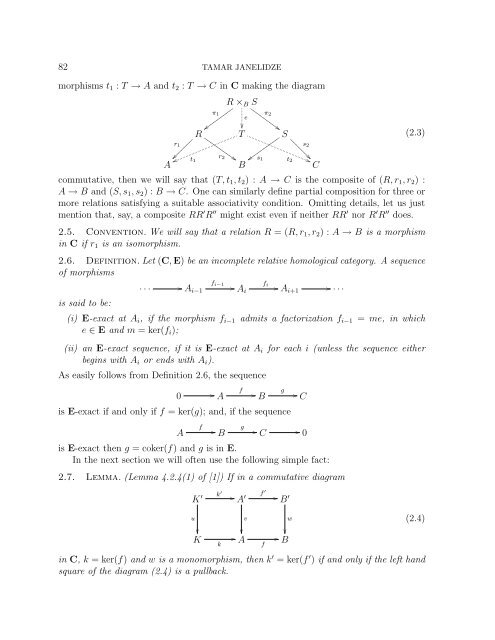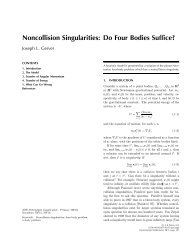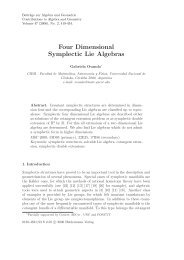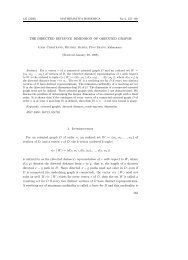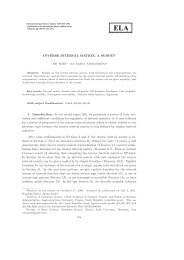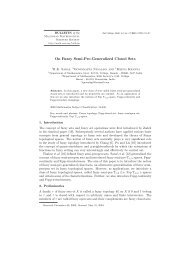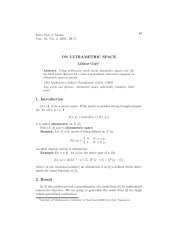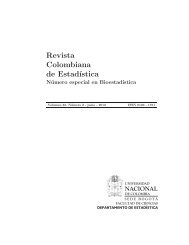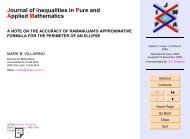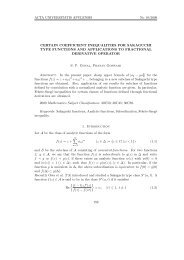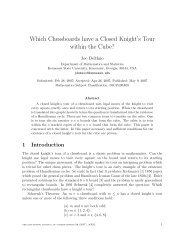SNAKE LEMMA IN INCOMPLETE RELATIVE HOMOLOGICAL ...
SNAKE LEMMA IN INCOMPLETE RELATIVE HOMOLOGICAL ...
SNAKE LEMMA IN INCOMPLETE RELATIVE HOMOLOGICAL ...
You also want an ePaper? Increase the reach of your titles
YUMPU automatically turns print PDFs into web optimized ePapers that Google loves.
82 TAMAR JANELIDZE<br />
morphisms t 1 : T → A and t 2 : T → C in C making the diagram<br />
R<br />
R × B S<br />
<br />
π 1<br />
π 2<br />
e<br />
<br />
T <br />
<br />
r <br />
1<br />
s 2<br />
t<br />
r<br />
2 1<br />
s 1 t 2 <br />
A B C<br />
S<br />
(2.3)<br />
commutative, then we will say that (T, t 1 , t 2 ) : A → C is the composite of (R, r 1 , r 2 ) :<br />
A → B and (S, s 1 , s 2 ) : B → C. One can similarly define partial composition for three or<br />
more relations satisfying a suitable associativity condition. Omitting details, let us just<br />
mention that, say, a composite RR ′ R ′′ might exist even if neither RR ′ nor R ′ R ′′ does.<br />
2.5. Convention. We will say that a relation R = (R, r 1 , r 2 ) : A → B is a morphism<br />
in C if r 1 is an isomorphism.<br />
2.6. Definition. Let (C, E) be an incomplete relative homological category. A sequence<br />
of morphisms<br />
is said to be:<br />
. . . A i−1<br />
f i−1 A i<br />
f i Ai+1 . . .<br />
(i) E-exact at A i , if the morphism f i−1 admits a factorization f i−1 = me, in which<br />
e ∈ E and m = ker(f i );<br />
(ii) an E-exact sequence, if it is E-exact at A i for each i (unless the sequence either<br />
begins with A i or ends with A i ).<br />
As easily follows from Definition 2.6, the sequence<br />
0 A<br />
f<br />
g<br />
B<br />
is E-exact if and only if f = ker(g); and, if the sequence<br />
C<br />
A<br />
f<br />
B<br />
g<br />
C 0<br />
is E-exact then g = coker(f) and g is in E.<br />
In the next section we will often use the following simple fact:<br />
2.7. Lemma. (Lemma 4.2.4(1) of [1]) If in a commutative diagram<br />
K ′ k ′ A ′ f ′ B ′ w<br />
u<br />
K<br />
k<br />
A<br />
v<br />
f<br />
B<br />
(2.4)<br />
in C, k = ker(f) and w is a monomorphism, then k ′ = ker(f ′ ) if and only if the left hand<br />
square of the diagram (2.4) is a pullback.


